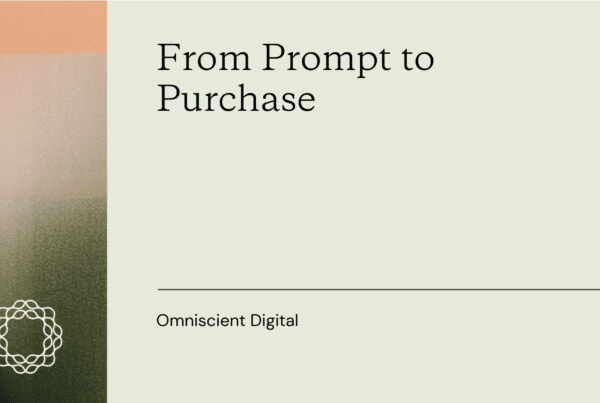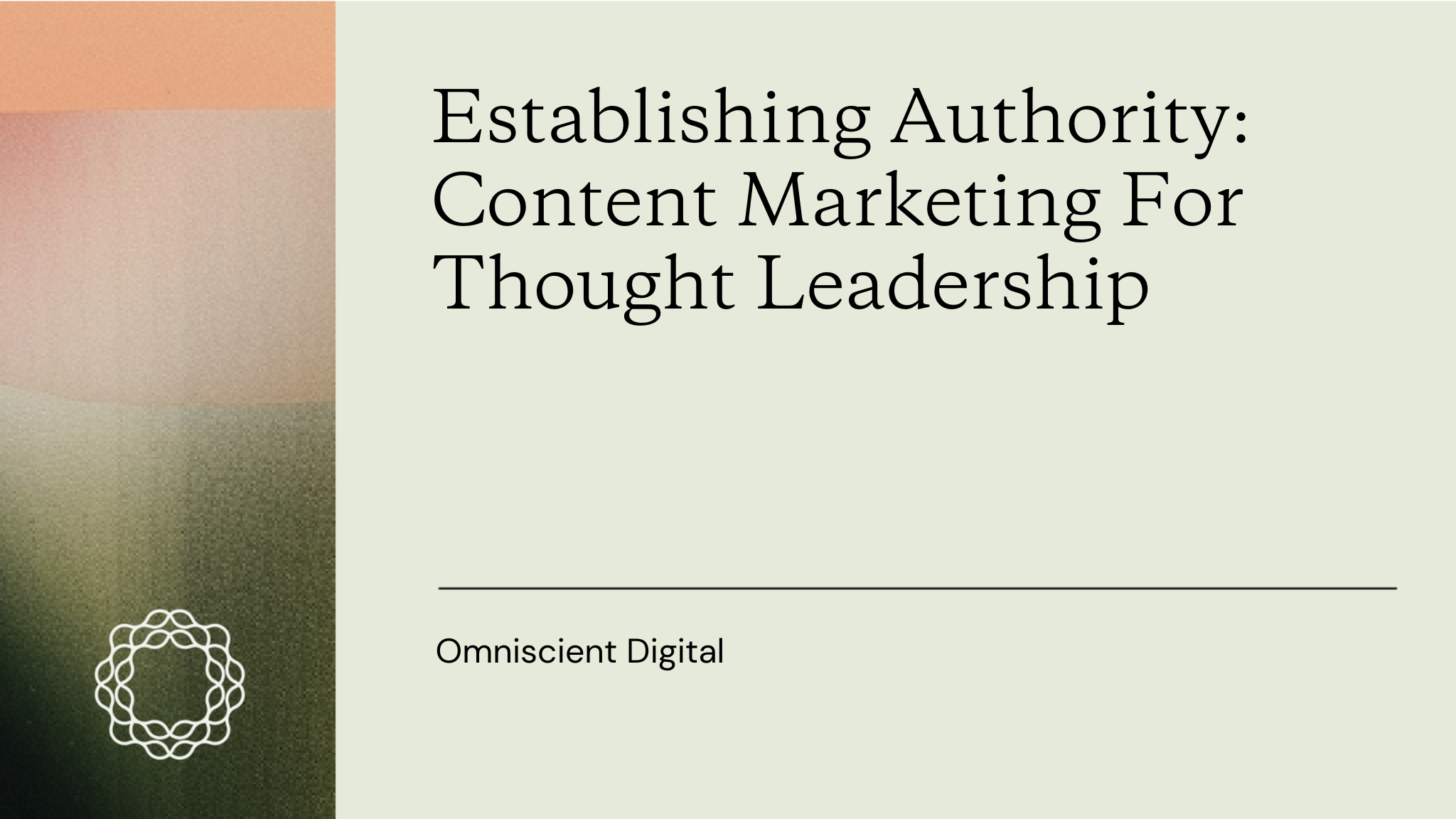
Your brand voice can help you inch your way closer to your target audience—or push them away.
But it’s not necessarily about the style and tone you use throughout your content (though, of course, that matters, too). It’s more about the subject matter expertise and experience you have to share. It’s about delivering valuable content that aligns with your audience’s intent, needs, and desires.
When your content marketing strategy is grounded in thought leadership, you position your brand as authoritative. This helps you build trust and inspire brand loyalty.
Let’s take a closer look at thought leadership marketing and how you can start writing authoritative content that builds trust with your ideal customer.
What is thought leadership & why does it matter?
Thought leadership content marketing means writing authoritative content and publishing it across your marketing channels. You can also create authoritative videos, infographics, and other visual content assets, like carousels.
Having a thought leadership strategy helps your brand stand out from the crowd.
You’re not simply posting tips and tricks. You’re delivering tremendous value that can change your audience’s life or business for the better. That’s why leadership content is pivotal to building trust, attracting a loyal audience, and encouraging business growth.
Consider a project manager looking for advice on how to manage resources and build better timelines. Would they head to a general blog and search for project management topics? Or would they choose an online publisher that specializes in project management and has years of experience to prove it?
While the first option may offer some valuable advice, the publisher isn’t a project management expert. The second option is the safest bet as it gives the reader an industry leader they can trust.
How can content marketing support industry thought leadership? (2 brand examples)
Content marketing is a powerful tool for brands to establish thought leadership in their respective industries.
By creating high-quality, informative, and engaging content, brands can position themselves as authoritative voices and trusted sources of information within their niches.
This helps attract potential customers actively searching for products and services, build brand credibility, and foster long-term relationships with existing customers.
Aventon, an electric bike company, for example, exemplifies content marketing for thought leadership. On its blog, social media channels, and educational resources, it shares valuable insights about e-bikes, including important maintenance tips, gear options, riding techniques, and the latest industry trends.
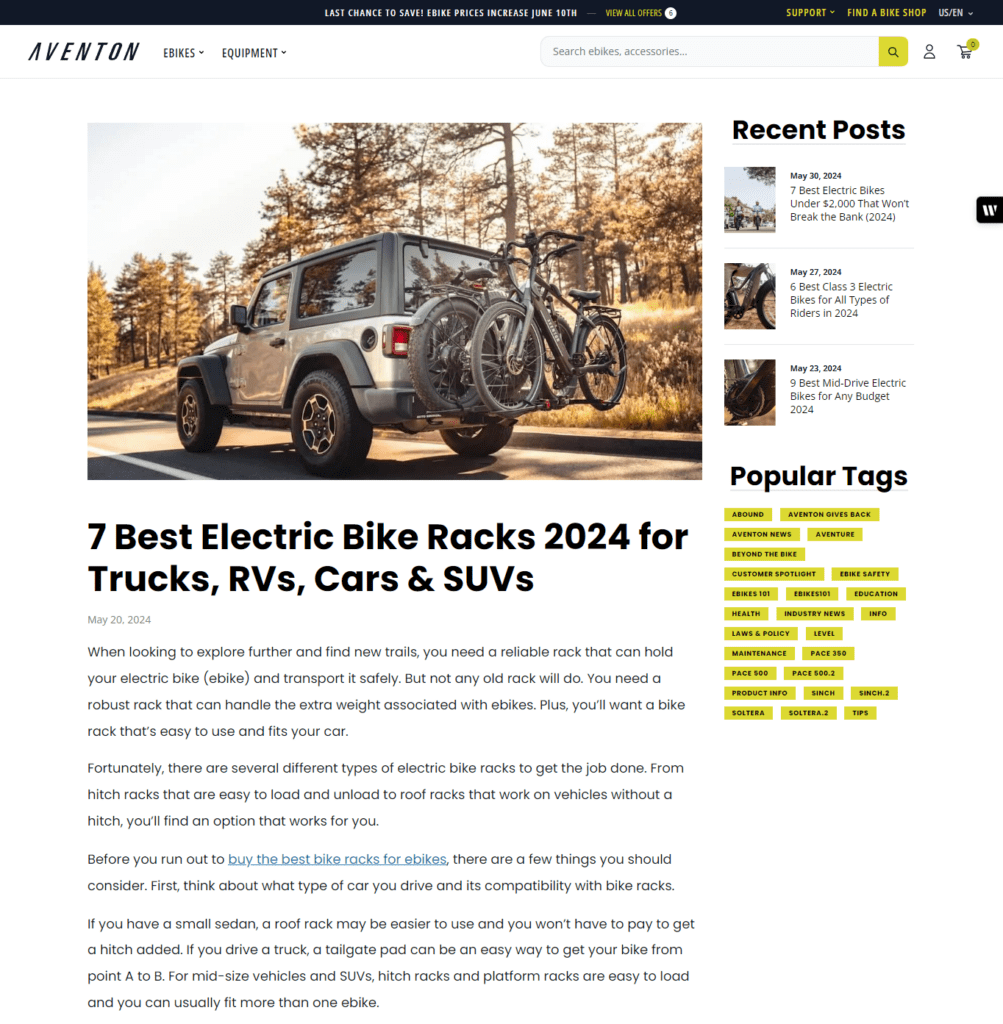
By consistently delivering relevant and informative content in the e-bike space, Aventon demonstrates its expertise in the field—and establishes itself as a go-to source for e-bike enthusiasts and potential buyers.
This enhances its brand visibility and cultivates trust and loyalty among its audience. It also inspires customer acquisition and retention.
The Aurit Center, a divorce mediation firm, also uses content marketing to position itself as a thought leader in its industry. By sharing expertise and insights about navigating a divorce peacefully, the firm demonstrates knowledge, and it fosters trust and reassurance with clients navigating one of the most challenging periods of their lives.
For example, the company publishes complete guides to divorce mediation by state, discusses the benefits of mediation over litigation, and shares blog posts about effective co-parenting and navigating divorce grief.
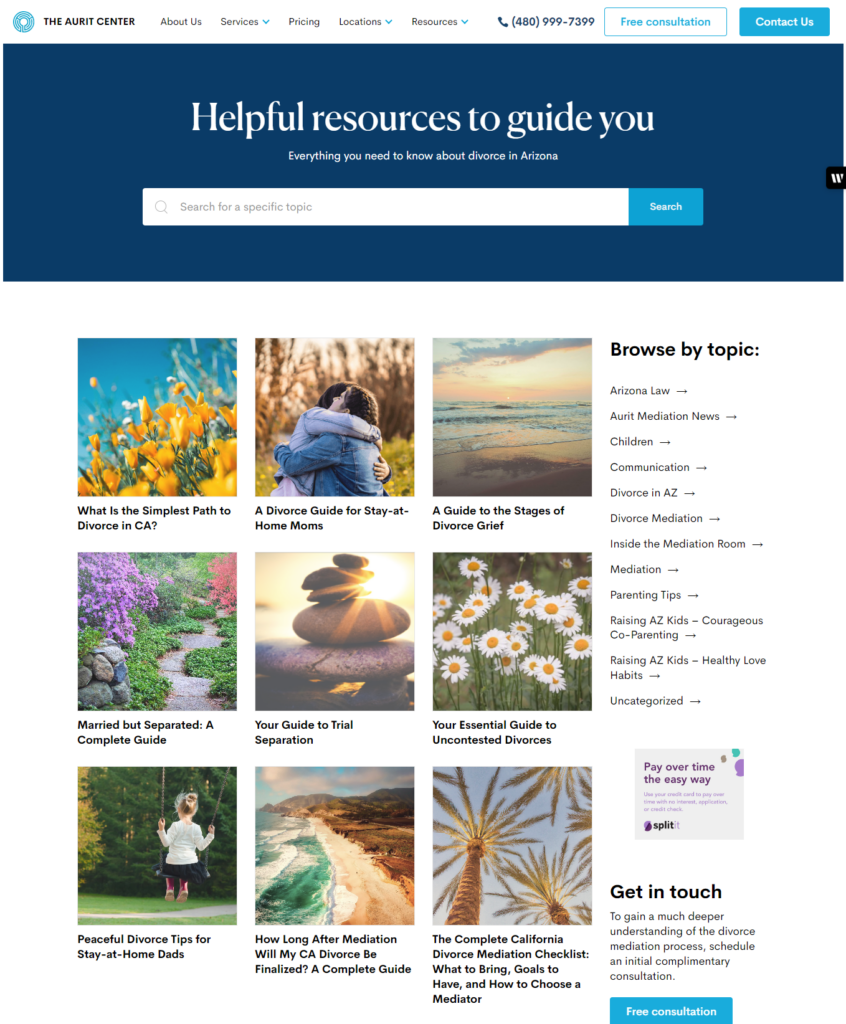
Its topical authority helps the firm establish itself as a thought leader in its field. Spouses seeking amicable divorce solutions know they’re in good hands when they see its in-depth mediation resources.
Developing a content marketing strategy for thought leadership
Ready to follow suit and demonstrate industry expertise with thought leadership content?
Follow these steps:
Identify your niche and expertise
What are you an expert in? What topical authority does your brand have? Center your content strategy around those key pillars.
Here’s an example of topic clusters a sustainable fashion brand might specialize in:
Main topic 1: Sustainable materials
Sub-topics:
- Recycled fabrics
- Organic cotton
- Vegan leather
Main topic 2: Ethical manufacturing
Sub-topics:
- Transparent supply chains
- Fair trade practices
- Labor rights
Main topic 3: Eco-friendly fashion design
Sub-topics:
- Upcycling and recycling
- Zero-waste design
- Minimalist fashion
For a real brand example, get inspired by Zhena Muzyka, the founder of Magic Hour. She’s a master tea blender, motivational speaker, podcast host, women’s business & life coach, and bestselling author of Life by the Cup.
Zhena consistently creates high-quality content across various platforms about wellness and mindfulness, with a special focus on tea.
Her topic clusters include:
- Tea blends (health benefits, historical significance, and new blend announcements)
- Teas for ailments (restful sleep, hormone balance, focus)
- Individual teas (health benefits, recipes, how they’re made)
She focuses on what she knows best: tea. So creating recipes for butterfly blue tea makes sense for her brand.

Beyond recipe cards, Zhena includes captivating photography, professional videos of herself making recipes, and thought leadership articles about tea-making.
She also engages with her tea-enthusiast audience on Instagram, sharing documentary-style videos about how Magic Hour tea is made and where it’s sourced.
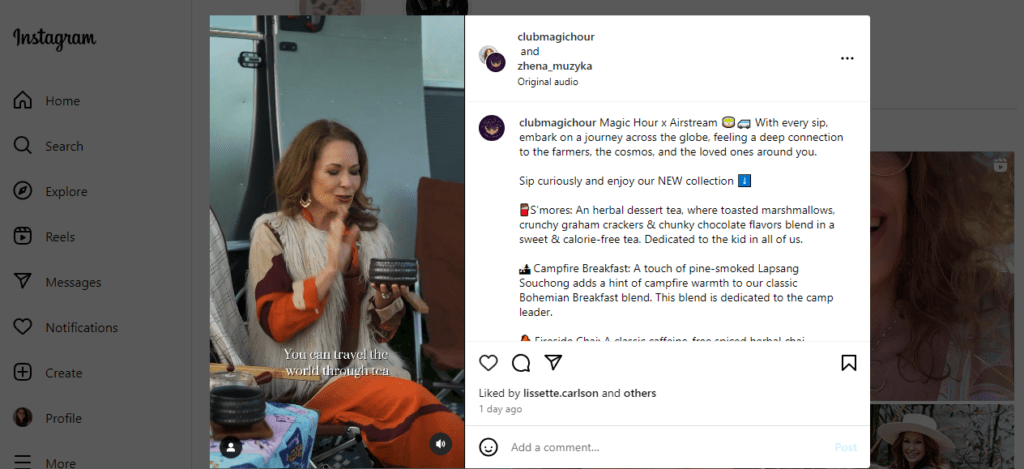
While Zhena could’ve focused Magic Hour on several beverage choices or food products, she chose to hyper-specialize in tea. With her passion, knowledge, and years of experience, she’s cultivated a loyal customer base and a strong presence as an industry thought leader.
Choose your content channels
Decide which channels you’ll use to promote thought leadership content.
We recommend creating a “home base” on your website and blog and then repurposing snippets across your other channels. This simplifies your approach and helps you maintain a consistent brand presence across all customer touchpoints.
Consider your brand goals and target audience when choosing your channels.
For example, if you have a B2B marketing agency, you might target channels like LinkedIn, X, and YouTube. If you run an ecommerce store, you might target channels like Instagram, TikTok, and Pinterest.
Other channels include:
- User community groups
- Community groups
- Podcast
Create your content
Conduct keyword research in Semrush or Ahrefs to identify which specific keywords to target in your topic clusters. Choose ones that align with your expertise and audience intent and have a low competition score.
Then, prepare content briefs that describe the thought leadership content you’ll create. Hand these off to subject matter expert ghostwriters and create a standard operating procedure (SOP) they can follow to make sure your content remains on-brand.
For some leadership pieces, you may need to contribute your own valuable insights. For example, specific experiences you’ve had, a personal story, or interviews you’ve conducted.
When you’re posting thought leadership on LinkedIn or another social media channel, repurpose assets from your blog and add your own touch to them. For example, turn a blog post into a carousel about current industry trends, complete with your own original research and anecdotes.
Some other thought leadership content examples include:
- Recorded speaking engagements
- White papers
- Case studies
- Webinars
- Reports
- Ebooks
Consider outsourcing your thought leadership content to a trusted SEO agency for support.
Establish a cadence for posting
Post consistently to give your audience (and show search engines) a dependable online presence.
Create a content calendar to plan your posts in advance. This helps you stay organized and have a steady stream of content.
Try to post at least once or twice a week—depending on your audience’s preferences and your capacity—and track engagement metrics to determine the best days and times to post and adjust your schedule accordingly.
*Pro-Tip: Use project management tools to keep track of deadlines and progress.
Amplify your content and reach your audience
Simply creating great content isn’t enough—you also need to make sure it reaches the right people.
Share your posts on social media platforms where your audience is most active. Engage with your followers by responding to comments and messages. Collaborate with influencers or other brands in your niche to expand your reach. Use email marketing to keep your subscribers informed about new content and use a lead magnet to continue growing your subscribers.
Consider investing in paid promotions or ads to target specific demographics and drive traffic to your site. Always analyze content performance and adjust your strategies to maximize reach and engagement.
*Pro-tip: Go the extra mile by creating a community group (I prefer Skool as it has gamification features) you can share content with via social media, your own app, or text.
Measure your thought leadership success
To understand your thought leadership impact, regularly track and analyze key performance indicators (KPIs).
Start with metrics like website traffic, social media engagement, and number of leads generated.
Use tools like Google Analytics to monitor the time users spend on your site and which content they find most engaging, then feed those insights into your knowledge management strategy to guide future content creation.
Measure the number of backlinks and mentions from other reputable sites—these indicate your influence in the industry. Track conversions, such as newsletter sign-ups or inquiries, to see how your content drives action.
Finally, gather feedback through surveys and direct conversations to understand how your audience perceives your expertise. Regularly review this data to refine your strategy and continue to grow your thought leadership presence.
How to overcome common challenges in content marketing thought leadership
Thought leadership content requires strategy and time to create.
Here are some challenges you might come across when creating thought leadership content—and how to overcome them.
Challenge 1: Finding time to create content
Solution: Plan your content creation process by setting aside dedicated time each week. Consider batching tasks, such as writing multiple blog posts in one sitting. Outsource or delegate tasks when possible to free up your time for strategic thinking.
Challenge 2: Generating fresh ideas
Solution: Stay informed about industry trends by following news sources, blogs, and trusted social media profiles. Attend webinars, conferences, and workshops to gain new insights. Engage with your audience to understand their pain points and questions, and use these interactions as inspiration for content.
Challenge 3: Building engagement
Solution: Create interactive and engaging content that encourages discussion, such as polls, Q&A sessions, and live videos. Respond promptly to comments and messages to foster a sense of community. Collaborate with influencers and industry experts to broaden your reach and credibility.
Challenge 4: Adapting to changing trends
Solution: Use competitive intelligence analysis and market research to stay ahead of thought leadership trends. Be flexible in your content strategy, ready to pivot and adapt based on new information and audience feedback.
Challenge 5: Balancing promotional and educational content
Solution: Aim for a balanced mix of content by planning your calendar to include both educational and promotional posts. Focus on delivering value first, with promotional messages subtly integrated into the content. Use storytelling techniques to make promotional content more engaging and relevant.
Challenge 6: Overcoming audience skepticism
Solution: Build trust by being transparent about your processes and expertise. Share success stories, testimonials, and case studies that showcase real results. Consistently provide high-quality, accurate, and valuable information to establish credibility with your audience.
Conclusion
Implementing a thought leadership marketing strategy is crucial if you’re looking to establish authority and build trust in your industry.
By consistently creating high-quality, valuable content, you can position yourself as an industry leader and foster brand loyalty.
A successful thought leadership strategy involves careful planning, tracking, and reiteration.
You’ll need to:
- Identify your niche and expertise
- Choose your content channels
- Create your content
- Establish a cadence for posting
- Amplify your content and reach your audience
- Measure your thought leadership success
Continually evolve and refine your approach to maintain a competitive edge and sustain your influence over time.
Need help creating ongoing thought leadership content? At Omniscient Digital, we can match your brand voice perfectly. As a content production and growth agency, you can trust us to move the needle.
Book a free consultation now to learn more about content creation for digital visibility, stronger authority, and better online sales.
Here’s to your success!

Author Bio:
Kelly Moser is the co-founder and editor at Home & Jet, a digital magazine for the modern era. She’s also the content manager at Login Lockdown, covering the latest trends in tech, business and security. Kelly is an expert in freelance writing and content marketing for SaaS, Fintech, and ecommerce startups.

